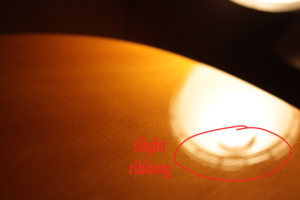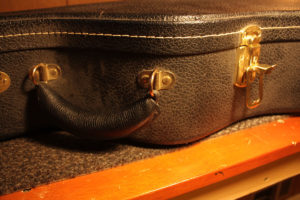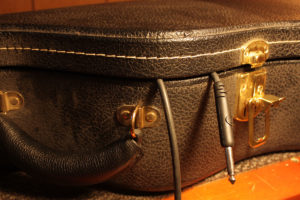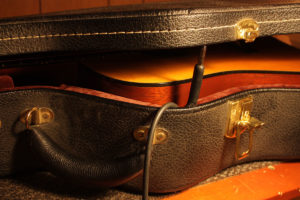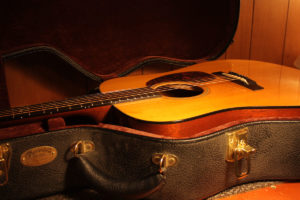What is humidity?
Humidity is a term used to describe the amount of water vapor present in air. Ok, that’s pretty simple right? If there is very little water vapor in the air, then it will feel very dry outside and your skin might feel itchy. Same with a lot of water vapor in the air, you will probably feel like you’re in a hot jungle. We’re probably all familiar with the differences of these two and how much they can affect our bodies. Well a wood instrument is no different. Humidity has a huge impact on instruments, especially acoustic guitars, and it is important that we know how to care for our guitars properly, and catch the warning signs of improper humidification early.
According to Taylor, the American guitar maker, an acoustic guitar wants to be around 45 – 55% humidity [source]. Interestingly enough, ASHRAE (American Society of Heating, Refrigerating and Air-Conditioning Engineers) recommends keeping your home at 45 – 55% humidity. This is actually the most healthy humidity range as it is the least hospitable for bacteria, viruses, and other health issues. Check out this link for a great infographic on humidity and your home [link].
In the summers we have to look out for high humidity, and in the winters we have to be on the watch for low humidity. Especially if you heat your home with a wood stove. This saps moisture from the air and can cause serious damage to instruments if care isn’t taken. I spent years testing different types of humidifiers, bringing my guitars into the bathroom when I showered (yes, seriously), and worrying about how dry my guitars were without ever actually knowing the humidity. The best thing to do is pick up a hygrometer. Amazon has a bunch of great digital ones for around $10. They’re well worth the money so you’re not guessing anymore about whether to boil a pot of water on the stove, or sprinkle everything in a thin layer of salt. This will help not only your instruments, but also you health and the rest of your home.
But what is “relative humidity”?
Relative humidity is the ratio of actual moisture in the air to the maximum amount of moisture the air will hold at its present temperature. Warmer air has the ability to hold more moisture. So if the temperature increases and the absolute moisture increases at the same ratio, the relative humidity will stay the same. In winter when the temperature decreases, the absolute humidity also decreases. However, this may not be a bad thing as the colder winter air has less ability to hold moisture. Remember, it is the ratio of water in the air to the air’s ability to hold water at a given temperature. It’s important to note that hygrometers measure relative humidity. So what you see on the meter should be used to determine if you need to humidify or not.
The relationship between wood and humidity
Wood reacts to relative humidity, so again it is the hygrometer’s reading that is important here. If the temperature decreases and the relative humidity remains constant, then your guitar’s wood will not move around. Workshopcompanion.com has some awesome information about wood and how it reacts to humidity changes. According to them, quartersawn wood is the least susceptible to humidity changes. Thankfully, acoustic guitar tops are made of (typically spruce) quartersawn wood, and the nicer and more uniform the grain of the top wood, the less it’s going to move around with humidity changes. When wood shrinks, it does so mostly across the grain. So if you’re imagining a guitar’s top, it will tend to shrink in thickness more so than in length or width. If a grain is not perpendicular to the cut, it is more likely to move in a side to side manner and cause serious damage. Higher quality guitar tops are generally less likely to damage with humidity changes because of uniformity of perpendicular grain.

When a tree is alive, it is made up of roughly 72% water. As it dries out, the wood will settle between 4% to 11% water content. Once the wood dries, it will never exceed 28% water content no matter how high the relative humidity. Interestingly, wood gains or loses about 1% water content with every 5% of change in relative humidity. By the time our guitars are built, the wood has been well dried and even though 1% doesn’t sound like a lot of movement, it’s enough to cause damage if we don’t take care to properly humidify. [source]
Humidity in which guitars are built
According to Martin Guitars, “Martin keeps the factory at a constant 45-55 percent humidity and 72-77 degrees Fahrenheit. If either humidity or temperature get far away from these factory conditions, your guitar is in danger.” [source] Thankfully, the humidity that guitars are built in is the same as the recommended humidity for your home. Keep your home in the 45-55 percent humidity range, and your health and instruments will thank you.

Now, using a large humidifier in your home is a great idea when it’s dry out. However, this may not be enough to get the humidity in the magic range, especially if you’re heating your home with a wood fireplace. This is when a special guitar humidifier is absolutely necessary. The best thing to do by far is keep your guitar in its case. It’s much easier to regulate the moisture level within the confines of a hard case than it is to keep your whole house at the correct humidity. Check out the article on solid top guitars here and scroll to the bottom to find my favorite guitar humidifiers.
For this reason, it’s important to buy a small battery powered hygrometer that can fit inside the guitar case. It’s cheap insurance at around $10 to know that your guitar is well taken care of.
Is Too Much Moisture a Bad Thing?
We’ve pretty much only talked about low moisture conditions. However, too much moisture can have devastating effects on a guitar as well. When a guitar is in very high humidity, the wood swells resulting in high action and possible bulging and separation of the top. Another major concern of high humidity is mold and mildew. I have seen some pretty gnarly guitar innards which are very hard to clean. It’s much easier to add moisture into a guitar than it is to clean mold out of the depths of a dreadnought.
Guitars that are too wet will also have a very dead and muffled sound to them. The saddest thing I saw was a vintage Martin D-35 that was in immaculate condition and the apple of the proud owner’s eye. It was one of the worst sounding acoustics I’ve ever played. It was totally dead and sounded like it was strung with rubber bands. Don’t let this happen to you! Keep your guitar in it’s humidity range!
Understanding the Signs of a Dried Out Guitar
Are you reading this and thinking, “Is my guitar dried out? How will I know?” Check out these signs that your guitar is on the dry side.
Ribbing
As we’ve found, wood moves across the grain. So an acoustic’s top will shrink (in dry conditions) in its thickness. The grain line doesn’t shrink at the same rate, and as the wood in between the grain lines shrink, leaving a ribbed texture across the guitar top. Guitars with thinner lacquered tops show these ribs more than a thicker urethane top.
To check this, run the back of your fingernails gently perpendicular to the grain lines. If you can feel those bumps then you need to check the humidity with a hygrometer.
Checking
Finish checking happens to lacquer finish as it ages, and it can also happen when temperature changes quickly, or a guitar dries out. It looks like small cracks in the finish and can crack in long lines, or in smaller random squares. If your guitar has not been subjected to large temperature swings, then there’s a good chance that it’s humidity related. Keep a close eye on your guitar’s finish as it might indicate low humidity.
Fret Buzz / Notes Choking Out
When your guitar’s top dries out it will drop slightly, causing the strings to buzz against the frets. Typically as you move up the fretboard away from the natural relief of the guitar net, you’ll start running into notes that will “fret out” or “choke out.”
Don’t let a guitar tech (well meaning or not) try to fix this problem by doing any fretwork. If you then fix the humidity issue, your frets will be all messed up.
Sharp Fret Ends

As a fingerboard dries out, it will shrink from side to side and the metal which unsurprisingly does not shrink, will stick out uncomfortably from the edge of the fretboard. If you’re looking to buy a guitar from a guitar shop, make sure that you can’t feel sharp frets. If you do, make the shop file those down before you agree to buy it.
To check for this, put your thumb and forefinger on either side of the fingerboard and run your hand up and down the neck. It will be very obvious if frets are sticking out. These can be very painful when playing the guitar, so make sure that sharp frets are taken care of, and if you do see this make sure to watch the humidity of your guitar.
Transporting a guitar in the cold
I mentioned above that finish checking can occur when a large temperature swing occurs. Therefore, never take your guitar outside of your house in the winter. Just kidding, but there are extra considerations when it comes to moving your guitar around when it’s cold outside. If it’s possible, don’t open the case right away. Let your guitar sit in its case until it has a chance to warm up a bit. If you can’t, then do this:
- Unlatch the case and do not open the lid
- Come back a couple minutes later and lift the lid slightly (not more than half an inch), stick something between the case and the lid and leave it for a couple more minutes. An instrument cable works great for this. It is just the right thickness to allow a little warm air into the case, and its soft rubber or cloth won’t scratch your guitar.
- Come back a bit later and slowly open the case the rest of the way.
By doing this, you’ll increase the chance of your guitar acclimating nicely to the temperatures it has been subjected to. Keep your guitar in the cold for as little time as possible, and of course, make sure that you’re properly humidifying your guitar and you’ll have less of these temperature and humidity related issues. Using something to prop open your case, make sure it’s not going to scratch your guitar. The cable end works, but I wouldn’t leave it like that if there was a chance that it could get bumped.
If you are moving your guitar around much at all, look into getting a TRIC case. These are incredible cases that protect your guitar against temperature and humidity changes. These cases are well worth the expense. Check them out in this post here.
So My Guitar is Dried Out, What Do I Do Now?
First, get a good quality humidifier and get your guitar back to that 45% – 55% humidity range. If you don’t have a hardshell case, get a Dampit humidifier as it has a plastic cover that keeps the humidifying sponge and wetter air inside the guitar.
9 and ½ times out of 10 this is the proper course of action, and the guitar will bounce back in no time. If the guitar is in desperate need of major humidification, there are a couple different methods that can be used. With all of these methods, make absolutely certain that direct water is not contacting the instrument. This is a sure way for mold to start growing.
1) Take a shower with your guitar!
Well, don’t actually bring it into the show with you, but bring it into the bathroom where it is subjected to higher temperatures and humidity levels. This won’t do much however if the rest of the house is at a much lower humidity. This will only subject the guitar to swings that may damage the guitar.
2) Put It In The Trash
Take a non scented trash bag (what’s less rock and roll than your guitar smelling like lavender) and fill the bottom with a wet towel that has been wrung out. Stick the guitar into the trash back and tape the top of the bag around the base of the neck of the guitar so that only the neck is sticking out of the bag. Make sure the bag is big enough (large leaf bags work best for this) so that the body of the guitar doesn’t touch the wet towel. Hang up the guitar by the neck or headstock making sure that the guitar still is not touching the wet towel. Check on the guitar every couple of days to either wet the towel, or end the process.
3) Tape The Hole
Finally, this is my favorite method. Pull the strings off the guitar, and lay it down flat. Take a small plastic cup and fill it with about ¼ inch of water. Put a cloth down inside the guitar and place the dry cup of water into the body of the guitar through the sound hole. Make sure the cup isn’t going to tip over into the guitar. This would be incredibly bad and would surely cause serious and even irreparable damage.
Tape over the soundhole with painters tape and place the guitar very carefully into its case. Leave the case horizontal, and set aside. MAKE SURE NO ONE TOUCHES IT. Leave nasty notes. Set booby traps. Do whatever you have to do to make sure that no one causes that cup of water to spill. As I mentioned, this would be disastrous. This is a dramatic way to reintroduce water back into your guitar and breathe life back into a dried out instrument.
Maintenance Mode
Now that your guitar is in the correct humidity range, and you’re monitoring the humidity with a digital hygrometer, keep your guitar happy by a humidification system that works for you. Like I mention in the Solid Top Guitar post, the Dampit works great for a guitar that is both in the case and on a stand, while the Humidipak works great for a guitar in its case and will regulate both dry and wet conditions.
Make sure to pay attention to the warning signs of both high and low humidity, and with a little care, your favorite acoustic guitar will play and sound great for many many decades.


